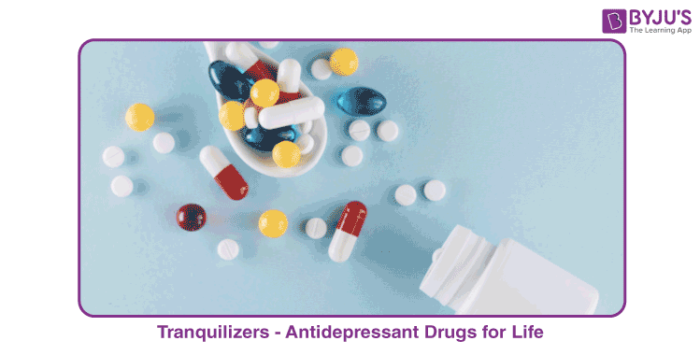Introduction
Analgesics and tranquillisers are drugs that act on the nervous system. They affect the message transmission that happens from nerves to receptors.
Table of Contents
What Are Tranquilisers?
The term ‘tranquilliser’ can also refer to anti-anxiety medication. The term was introduced in the year 1953 to describe drugs that have a calming effect. They are chemical compounds which are very useful in the treatment of stress and mild or severe mental diseases.
- They induce a sense of well-being in a person, thereby releasing them from stress, tension, anxiety or irritability. They are one of the essential components of sleeping pills.
- There are many types of tranquillisers, and each has different modes of functioning.
- For example- a tranquilliser which helps in uplifting mood is called noradrenaline. If the level of noradrenaline is low, then the signal-sending activity also becomes low, which in return makes a person feel depressed. In these situations, antidepressant drugs or a tranquiliser can be used.
- These drugs inhibit the action of those enzymes that catalyse the degradation of noradrenaline. When the enzymes are inhibited, noradrenaline is slowly metabolised, and therefore, it activates its receptors for a longer duration of time, and so, the effect of depression is counteracted.
Classification of Tranquillisers
Tranquillisers come in two varieties:
- Minor Tranquillisers
- Major Tranquillisers
Minor Tranquillisers, also called anxiolytics, are used for sedation and to treat anxiety. Today, these drugs are called anti-anxiety medications.
Major Tranquillisers, also called neuroleptics, were developed to treat psychiatric disorders, including schizophrenia. These drugs combat hallucinations and other delusions. Usually prescribed for long terms, Major Tranquillisers include phenothiazines, thioxanthenes, butyrophenones, clozapine and rauwolfia alkaloids.
Like all drugs, tranquillisers have the potential for producing side effects, sometimes one’s even when taken in recommended dosages. Low dosages of mild tranquillisers may cause drowsiness and a loss of coordination that resembles drunkenness. These reactions tend to occur when the patient first begins taking the medication but can develop later when an accumulation of the medication occurs. A significant depression of mood can be a side effect of prolonged use of tranquilisers
Examples of Tranquilisers
Some examples of tranquilizers are iproniazid and phenelzine.
Some tranquillisers are relatively mild in nature and are suitable for relieving tension. Equanil is used in controlling depression and hypertension. We have barbiturates, which are hypnotic, that is sleep producing agents. Some substances, which are used as tranquilisers, are valium and serotonin.
Moving on to antiseptics, these are those substances which prevent the growth of microorganisms.
Antiseptics
- They are applied to living tissues, such as wounds, to prevent the growth of microbes and free the skin from any disease.
- Examples of antiseptics are furacine, soframicine etc. We also have antiseptic soaps that are commonly used; these soaps have bithionol added to it.
- Boric acid is also an antiseptic which is used for the eyes.
- Dettol is the most popular disinfectant used these days; it is a mixture of chloroxylenol and terpineol.
- Both tranquillisers and antiseptics are vital for the healthy survival of human beings.
To learn more about tranquillisers and analgesics, register with BYJU’S and download our app.



Comments